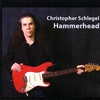Christopher Schlegel Update 02-14-2011
My first original music release of 2011 is this CD with 11 tunes of Hammerhead Maestro guitar artistry.
As stated on the CD:
This is an album of original guitar-based rock-style instrumental tunes. I used two 1970s Fender Stratocasters, one Reason Amps Bambino, one Marshall 50-watt JCM800 half-stack, and one Create DXB112. I hope you enjoy the music.
You may be curious about the title. It’s a rough translation of my name in the original German.
http://en.wikipedia.org/wiki/Schlegel
Years ago, I read this in a book about name origins and was very amused by it. I told several people and one of them, Carl King, started calling me Hammerhead; then, the Hammerhead Maestro. So, in effect, the title is, Christopher Schlegel, Schlegel. Now, about the style of music and playing on this CD.
There is the guitar style of playing a few notes, with tact & reserve. Then, there is the style of playing a lot of notes, with less reserve. Then, there is the style of playing too many notes, simply because you can think of many more to play before the song is over. Eventually, we arrive at the style of playing way too many notes, with no reserve whatsoever. At this point we arrive in virtuoso land & the player simply enjoys playing as much as he can think of because his mind is overflowing with wonderful ideas.
There is one more level, beyond even the level of way too many notes. This is the style of Hammerhead. It is a style proudly and unapologetically trailblazed by Ludwig van Beethoven, Nicolo Paganini, Franz Liszt, Sergei Rachmaninoff, Art Tatum, Joe Pass, Yngwie Malmsteen, among others. Essentially, my musical heroes.
Anyway, there is no such thing as too many notes. The only question is: how many notes are enough? The answer is: as many good ones as you can think of and play before the song is over without losing the melody. Some of us can THINK of more beautiful notes to play than other musicians. I am one of them and I will not refrain from playing all the good ones I can think of.
Have a listen to the brief samples on the CD Baby page:
http://www.cdbaby.com/cd/schlegel9
I’ll be posting more info about the individual songs in future updates. Enjoy!
